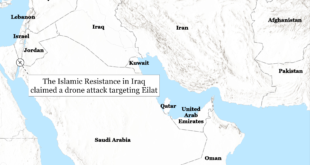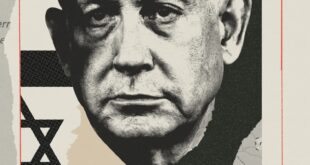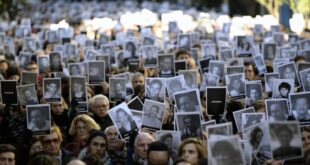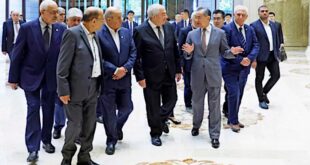 SUSIYA — The turnout is good. Four coach loads of people have come from all over Israel. There are two from Jerusalem, one from Tel Aviv and one from Herzliya. On a sunny January mid-morning, the maybe 200 people walking across the arid hills in the southern West Bank, with its unpolluted air and fine views, could be heading for a picnic.
SUSIYA — The turnout is good. Four coach loads of people have come from all over Israel. There are two from Jerusalem, one from Tel Aviv and one from Herzliya. On a sunny January mid-morning, the maybe 200 people walking across the arid hills in the southern West Bank, with its unpolluted air and fine views, could be heading for a picnic.
But life for the villagers who greet them is no picnic. Traditional cave dwellers, the people of Susiya today live in shabbily erected tents, temporary dwellings that give them shelter from the elements but not much more. These are no bedouins and living in tents is not their choice.
For some 25 years, the families of Susiya have fought their own battle with the Israeli army and Jewish settlers, so close, but a world away.
The original village of Susiya lies about half a kilometre from where the tents are erected today. There, a combination of natural caves and built structures had hosted its people for generations upon generations, as they made a living from their olive trees and sheep. Today, a large wall-less structure with an enormous orange roof stands on the site. It marks the spot where an archaeological team found ruins dating from the Roman and Hellenistic periods.
“Unfortunately for the villagers,†notes David Schulman, a professor of Sanskrit at Hebrew University in Jerusalem and an activist with the Israeli peace group Taayush (from the Arabic “coexistenceâ€), “there were also the ruins of an ancient synagogue.â€
The year was 1982. Ariel Sharon, as defence minister, had just initiated a “limited†invasion of Lebanon. The right had been in power in Israel since 1977 and the settlement movement was in its first real flowering.
Israeli archaeology was also flourishing, busy unearthing what activists hoped to be evidence of the accuracy of the Bible proof of Jewish history in the hills of the West Bank. Susiya, according to Schulman, is mentioned in the Old Testament and the synagogue find was gold dust.
Out, without further ado, went the villagers. In came first an archaeological dig, then the national park that stands today. The national park is the property of Israel, and all Israelis are allowed access. But the villagers of Susiya are not, and for 25 years they have looked at their former homes from a distance, a fence and a hilltop away.
In, too, came the settlers, and gradually and inexorably, the settlement project grew here. About half a kilometre exactly the opposite direction from where the tents stand, lies the settlement of Susiya, three kilometres inside West Bank territory. It is not alone.
A cluster of settlements has been built in the south Hebron hills, and villagers complain of constant harassment from the religious settlers in this area, who enjoy the protection of the Israeli army. Olive trees have been chopped down or uprooted and stolen.
Israel’s separation barrier was originally to have included all these settlements on their western Israeli side, but after several challenges, the route has been changed. Nevertheless, there is little doubt in villagers’ minds what Israel has in mind for the area’s future.
“They want to connect the settlement here with the national park there,†says Mohammad Nawajeh, pointing as he shows the assembled peace activists around. Three settlement outposts, all located so as to bear out Nawajeh’s prediction, are clearly visible.
If he is right, he and the other villagers are once again in the way. Nawajeh himself is a lawyer in the nearby town of Yatta, but his family is originally from the village where he owns land, and he has taken on the task, along with the Israeli human rights groups to fight the expulsion of the families. On January 29, the Israeli supreme court is due to meet to decide what will happen to the Susiya families. So far, the court and the Israeli peace activists have been the only friends of these families.
The court has intervened before. In 2001, the court ruled that the families should have access to their olive trees and be allowed to graze their sheep. If need be, the ruling stated, the army should provide protection.
That never happened according to Nawajeh, though villagers tried to coordinate with the army. “They were always busy.â€
But that ruling came too late for the villagers, who earlier the same year had had to move into the temporary tents they now inhabit. After the outbreak of Al Aqsa Intifada, settlers and soldiers went on the rampage, this time destroying the caves the families had moved into after their first move.
“They came and used tractors, bulldozers and drills,†explains Nasrallah Mahmoud, 32, standing atop one cave his family had lived in. He points to marks on the side of what once was a cave roof to show drill marks still evident.
Since, a steady war of attrition has commenced with villagers too frightened to get too close to settlements. Having nowhere to go, and no desire to go there, villagers again await their fate. The Israeli supreme court and the activists gathered represent their best hope.
“The Palestinian Authority has done nothing for us,†says Mahmoud dismissively. He has grown used to the regular visits from Israeli peace activists and he welcomes them. Still, he has few illusions about his own power over his future.
“God will decide,†he says.
 Eurasia Press & News
Eurasia Press & News



